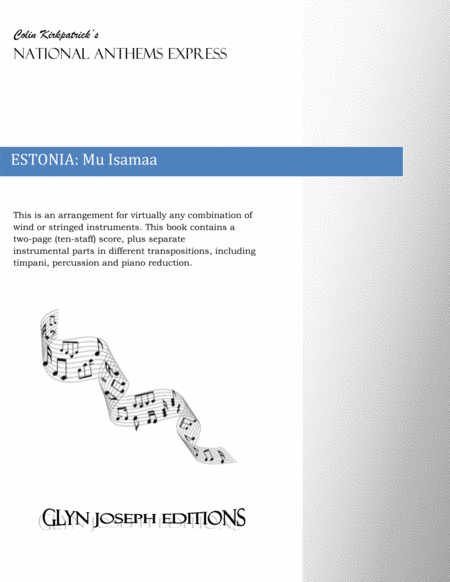Large Ensemble - Level 2 - Digital Download SKU: A0.522128 Composed by Fredrik Pacius (1809 - 1891). Arranged by Colin Kirkpatrick. Contemporary. Score and parts. 35 pages. Colin Kirkpatrick Publications #3382783. Published by Colin Kirkpatrick Publications (A0.522128). Colin Kirkpatrickâs National Anthems Express ESTONIA: Mu Isamaa This quick and easy national anthem arrangement is essential for traveling musicians, bands, instrumental groups and both amateur and professional ensembles. You can play it with any virtually any combination of instruments: symphonic band, clarinet choir, brass ensemble, brass band, solos, duets and trios - almost anything! This arrangement is in six independent parts each transposed into a variety of keys. For the most satisfying sound youâll need to get a good balance between each part possibly with an emphasis on the melodic line. If you have a non-standard ensemble, you can pick 'n' mix as required. The piano reduction can fill missing parts or can be used as the basis for an accompaniment. Note that this anthem is virtually identical to the anthem of Finland. There is a minor difference in part of the melody and the repeat structure is different. This arrangement consists of a two-page score with seven instrumental staves and three percussion staves. The following parts are printed on separate pages. The score and all the parts are contained in the same pdf file. Part 1 in B flat (clarinet, trumpet, cornet, flugelhorn, soprano sax); Part 1 in C (flute, oboe, piccolo, glockenspiel, violin); Part 1 in E flat (alto sax, E flat clarinet); Part 1a in C (octave above concert for flute, piccolo, oboe, violin) and Part 1a in E flat (E flat cornet in brass band). Part 2 in B flat (clarinet, trumpet, cornet, flugelhorn, soprano sax); Part 2 in C (violin); Part 2 in E flat (alto sax); Part 2a in C (octave above concert pitch for flute, oboe, violin); Part 2a in B flat for clarinets; Part 2a in E flat (minor 3rd below concert for E flat alto clarinet). Part 3 in B flat (tenor saxophone, B flat baritone); Part 3 in C (bass clef for trombone, bassoon); Part 3 in C alto (alto clef for viola); Part 3 in E flat (tenor horn, alto sax); Part 3 in F (French horn); Part 3a in B flat (8ve below concert for 3rd clarinets in band). Part 4 in B flat (tenor sax, baritone); Part 4 in C (bass clef for trombone, euphonium, bassoon, cello); Part 4 in E flat (tenor horn, alto sax); Part 4 in F (French horn). Part 5 in B flat (baritone); Part 5 in C (bass clef for trombone, euphonium, bassoon. Part 6 in B flat (B flat bass, bass clarinet); Part 6 in C (bass clef for bass trombone, bassoon, contrabassoon, tuba, double bass); Part 6 in E flat (E flat bass, baritone sax). Thereâs also a part for timpani, percussion (3 players) and a piano reduction. The arranger, Colin Kirkpatrick studied at Londonâs Royal College of Music and followed a career in music education. He was a High School Music Director for about fifteen years and later became a Music Education Adviser, with the added responsibility for training teachers and directing the instrumental teaching service. He has published a great deal of music and his publishers include Boosey & Hawkes, Novello, Paxton, Schott, Oxford University Press, Chester, Belwin Mills and Intrada (Netherlands). His music has been performed and broadcast all over Europe as well as in Japan, Thailand, Australia and the USA.
